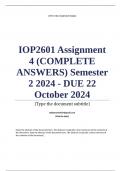[TYPE THE COMPANY NAME]
IOP2601 Assignment
4 (COMPLETE
ANSWERS) Semester
2 2024 - DUE 22
October 2024
[Type the document subtitle]
[Pick the date]
[Type the abstract of the document here. The abstract is typically a short summary of the contents of
the document. Type the abstract of the document here. The abstract is typically a short summary of
the contents of the document.]
, Exam (elaborations)
IOP2601 Assignment 4 (COMPLETE ANSWERS)
Semester 2 2024 - DUE 22 October 2024
Course
Organisational Research Methodology (IOP2601)
Institution
University Of South Africa (Unisa)
Book
Numbers, Hypotheses
IOP2601 Assignment 4 (COMPLETE ANSWERS) Semester 2 2024 - DUE 22
October 2024; 100% TRUSTED Complete, trusted solutions and
explanations.
QUESTION 1 [8] You have recently been appointed as a research assistant at
UNISA, working alongside a distinguished professor in the College of
Economic and Management Sciences (CEMS). Together, you are embarking
on an exciting study involving a group of 500 postgraduate research students.
The focus of the study is to explore whether there are differences in the levels
of commitment to research between male and female postgraduate students.
(a) If you were to select 250 of the 500 postgraduate students for this
research study, those selected would be your _______. (1) (b) The study
examines two variables: gender and commitment. What is the dependent
variable in the professor’s study? (1) (c) This type of research would be
classified as ______ statistics. (1) (d) In the research article “S. W. Mvana
(2023). Teacher Retention: Work Engagement, Psychological Capital, and
Human Resource Retention Practices Satisfaction in South Africa. Annals of
the University of Craiova for Journalism, Communication and Management, 9,
93-105,” Mvana hypothesised that work engagement is positively linked to
satisfaction with human resource retention practices. What is the independent
variable in this hypothesis? (1) (e) ______ variables indicate that there is a
difference between categories of objects, persons or characteristics. (1) (f)
Which scale of measurement uses numbers as labels that distinguish
categories? (1) (g) ______ scales of measurement indicate categories that
are not only different from one another, but also different in terms of rank or
order. (1) (h) When participants’ opinions are labelled as strongly agree,




